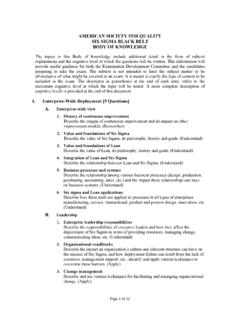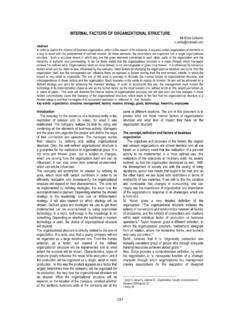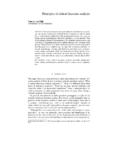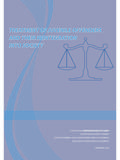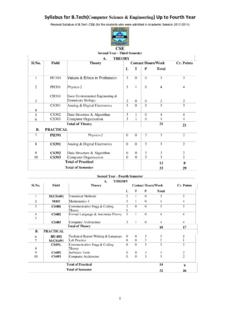Transcription of The structure and function of communication in society
1 Leti im kuram ve ara t rma dergisi Say 24 K -Bahar 2007, The structure and function of communication in society Harold D. Lasswell 1 T rkiye deki gibi hem siyasal bilgiler fak ltesinde diki tutturamay p ileti im fak ltelerine gelen, hem ileti imi hor g ren hem de ileti imin olma ko ulu olarak en az iki ki inin gerekti ini (g nderici ve al c olmas n ) ne s recek kadar bilgisiz olanlar yeti tirenlerin aksine, ABD de ileti im alan n kuran ve geli tirenlerin nde gelenleri sosyal bilimciler, zellikle sosyologlar ve siyaset bilimcileri, olmu tur. Nermin Abadan-Unat ve nsal Oskay gibi baz istisnalar d nda, hem politika ve ileti im aras nda do ru ve anlaml ba kuramayacak kadar yetersizlerin hem de bu yetersizliklerini ngilizceyi iyice renerek ve tembelliklerini yenerek giderme yerine okul odalar nda ayl -kahveli dedikoduyu se enlerin ve ileti im alan na, hi bir olumlu katk da bulunmad klar gibi, zarar verenlerin aksine, ABD deki siyaset bilimciler ileti imin geli mesine b y k katk da bulunmu lard r.
2 Bunlar n ba nda gelenlerden biri de H. Lasswell dir. Harold Lasswell ileti imde sadece bir form l ne s rmemi , ileti imin yap s ve toplumdaki i levleri hakk nda bir kuram geli tirmi tir. Lasswell in klasik kuram n n birka kelimelik form l tesinde bilinmesi ve bu g r n irdelenmesi gerekir. Lasswell in structure and function of communication in society makalesinden par alar sunulmas ndaki ama , ileti imin g nderici-Mesaj-Al c -Geribesleme er evesi i inde ele alan basitlikten ve Defleur gibi bilim adamlar n n ultra-tutucu ba nazl klar n n tesinde anla lmas d r. Bu sunum ileti imin mesaj g nderme-alma mekanik s re alg s n n tersine toplumda s reklili i sa lamayla ili kisini ortaya koymaktad r.
3 1 Original kaynak: Lyman Bryson (1948) (ed.) The communication of Ideas. New york: The Institute for Religious and Social Studies. Kaynak: Schramm, W. ve Roberts, D. F. (1971) The Process and Effects of Mass communication . Urbana: University of Illinois Press, s. 84-99. Forum H. D. Lasswell 216 The act of communication Convenient way to describe an act of communication is to answer the following questions: Who Says What In Which Channel To Whom With What Effect? The scientific study of the process of communication tends to concentrate upon one or another of these questions.
4 Scholars who study the "who," the communicator, look into the factors that initiate and guide the act of communication . We call this subdivision of the field of research control analysis. Specialists who focus upon the "says what" engage in content analysis. Those who look primarily at the radio, press, film, and other channels of communication are doing media analysis (p. 84). When the principal concern is with the persons reached by the media, we speak of audience analysis. If the question is the impact upon audiences, the problem is effect analysis.
5 Whether such distinctions are useful depends entirely upon the degree of refinement which is regarded as appropriate to a given scientific and managerial objective. Often it is simpler to combine audience and effect analysis, for instance, than to keep them apart. On the other hand, we may want to concentrate on the analysis of content, and for this purpose subdivide the field into the study of purport and style, the first referring to the message, and the second to the arrangement of the elements of which the message is composed. structure and function Enticing as it is to work out these categories in more detail, the present discussion has a different scope.
6 We are less interested in dividing up the act of communication than in viewing the act as a whole in relation to the entire social process. Any process can be examined in two frames of reference, namely, structure and function ; and our analysis of communication will deal with the specializations that carry on certain functions , of which the following communication in society 217may be clearly distinguished: (i) the surveillance of the environment; (2) the correlation of the parts of society in responding to the environment; (3) the transmission of the social heritage from one generation to the next.
7 Biological equivalences At the risk of calling up false analogies, we can gain perspective on human societies when we note the degree to which communication is a feature of life at every level. A vital entity, whether relatively isolated or in association, has specialized ways of receiving stimuli from the environment. The single-celled organism or the many-membered group tends to maintain an internal equilibrium and to respond to changes in the environment in a way that maintains this equilibrium. The responding process calls for specialized ways of bringing the parts of the whole into harmonious action (p.)
8 85). Multi-celled animals specialize cells to the function of external contact and internal correlation. Thus, among the primates, specialization is exemplified by organs such as the ear and eye, and the nervous system itself. When the stimuli receiving and disseminating patterns operate smoothly, the several parts of the animal act in concert in reference to the environment ("feeding," "fleeing," "attacking"). In some animal societies certain members perform specialized roles, and survey the environment. Individuals act as "sentinels," standing apart from the herd or flock and creating a disturbance whenever an alarming change occurs in the surroundings.
9 The trumpeting, cackling, or shrilling of the sentinel is enough to set the herd in motion. Among the activities engaged in by specialized "leaders" is the internal stimulation of "followers" to adapt in an orderly manner to the circumstances heralded by the sentinels. Within a single, highly differentiated organism, incoming nervous impulses and outgoing impulses are transmitted along fibers that make synaptic junction with other fibers. The critical points in the process occur at the relay stations, where the arriving impulse may be too weak to reach the threshold which stirs the next link into action.
10 At the higher centers, separate currents modify one another, producing results that differ in many ways from the outcome when each is allowed to continue a separate path. At any relay station there is no conductance, total conductance, or intermediate conductance. The same categories apply to what goes on among members of an animal society . The sly fox may approach the barnyard in a way that H. D. Lasswell 218supplies too meager stimuli for the sentinel to sound the alarm. Or the attacking animal may eliminate the sentinel before he makes more than a feeble outcry.

